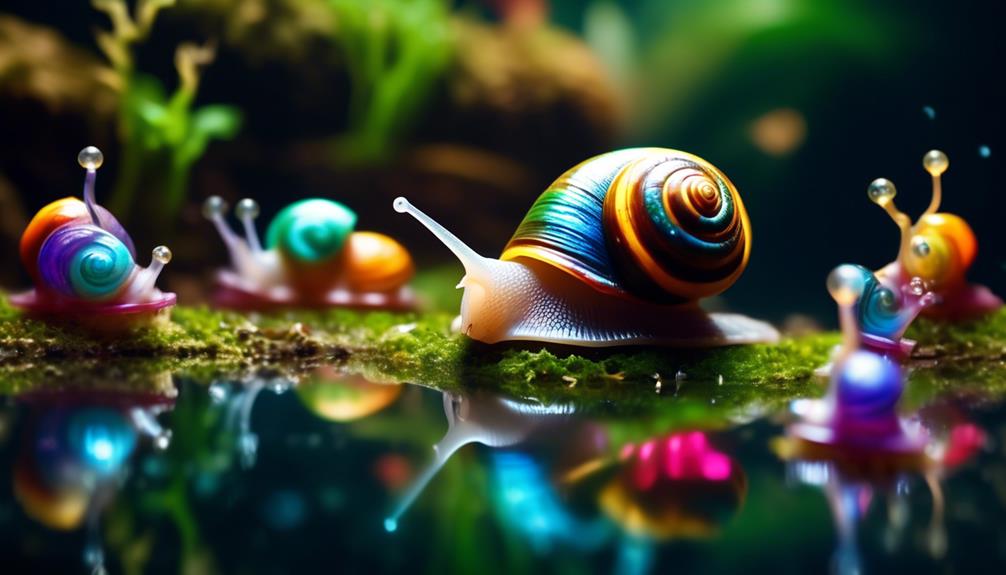Aquarium owners face a common challenge of dealing with unwanted snails in their tanks, which can quickly multiply and become a nuisance. Fortunately, there is a comprehensive guide available that offers effective strategies to eliminate these pesky creatures and restore the health and beauty of the aquatic environment.
From controlling snail reproduction to employing manual removal methods and utilizing snail traps, this guide has it all. Furthermore, it explores the natural control of snail populations through snail-eating fish and emphasizes the importance of quarantine methods to prevent the introduction of snails through new plants.
By following the expert advice provided, aquarium owners can successfully rid their tanks of snails, resulting in a cleaner, healthier, and visually appealing aquatic habitat. So, if you're tired of battling snails in your aquarium, sit tight and discover the ultimate solution to eliminate these pesky creatures once and for all.
Key Takeaways
- Feeding less food and only enough for fish to consume in a few minutes can reduce snail reproduction.
- Regularly pruning plants and scrubbing off algae can limit snail food sources.
- Manual removal methods such as physically picking out snails by hand or using a snail catcher tool can help control snail population.
- Using snail traps with delicious vegetables as bait or introducing snail-eating fish like pufferfish and loaches can also aid in eliminating snails.
Controlling Snail Reproduction
Controlling snail reproduction in aquariums can be achieved through various methods and strategies aimed at reducing their population and preventing further proliferation.
Snail overpopulation can have a significant impact on the aquarium ecosystem, leading to issues such as excessive algae growth, decreased water quality, and competition for resources with other aquatic organisms.
One effective approach is to regulate the snail reproductive cycle by feeding less food. By providing only enough food that can be consumed by fish in a few minutes, snail reproduction can be minimized.
Additionally, regularly pruning plants and scrubbing off algae can limit snail food sources. This helps to create an environment that is less conducive for snail reproduction, ultimately curbing their population and preserving the balance of the aquarium ecosystem.
Manual Removal Methods
One effective method for managing snail populations in aquariums is through the use of manual removal techniques. These methods involve physically picking out snails by hand or using a DIY snail catcher tool.
Regularly removing snails from the aquarium offers several benefits. Firstly, it helps to prevent the snail population from rapidly increasing and overwhelming the tank.
Secondly, it reduces the competition for resources between snails and other inhabitants of the aquarium, such as fish and plants.
Additionally, regular snail removal helps to maintain the aesthetic appeal of the tank by preventing snails from overpopulating and covering the walls and decorations.
Snail Traps

To further address the challenge of managing snail populations in aquariums, another effective method is the use of snail traps. Snail traps are specifically designed to attract and capture snails, making it easier to remove them from the tank. One popular DIY snail trap involves using vegetables as bait. Cucumber, zucchini, carrot, or lettuce can be dropped into the aquarium overnight. Snails will gather on the vegetable, allowing for easy removal. Another alternative snail bait for traps is snail pellets, which can be purchased from pet stores. These pellets contain ingredients that attract snails and can be placed in a trap with small holes for snails to enter but fish cannot pass through. By using snail traps with these alternative baits, aquarium owners can effectively reduce snail populations and maintain a cleaner and healthier tank environment.
| DIY Snail Trap | |
|---|---|
| Materials | A small container, such as a plastic cup or jar<br>Vegetables or snail pellets for bait<br>Scissors or a knife<br>Rubber band or tape |
| Instructions | 1. Cut small holes in the side of the container, large enough for snails to enter but too small for fish to pass through.<br>2. Place the bait (vegetables or snail pellets) inside the container.<br>3. Secure the bait with a rubber band or tape, ensuring it stays in place.<br>4. Submerge the trap in the aquarium, leaving it overnight.<br>5. In the morning, carefully remove the trap, taking care not to release any snails back into the tank.<br>6. Dispose of the captured snails away from the aquarium. |
| Tips | – Place the snail trap in areas where snails are most commonly found, such as near plants or hiding spots.<br>- Check the trap regularly to remove captured snails and refresh the bait.<br>- Repeat the process until the snail population is under control.<br>- Use multiple traps if needed to cover a larger tank area. |
Snail-Eating Fish
Snail-eating fish play a crucial role in controlling snail populations in aquariums due to their natural predation habits. These fish provide several benefits for aquariums by helping to keep snail populations in check. One of the main advantages is that snail-eating fish consume snails, thereby reducing their numbers and preventing overpopulation. This is especially important for beginners who may struggle to control snails in their aquariums.
Some of the best snail-eating fish species for beginners include freshwater pufferfish and various loach species. These fish not only enjoy eating snails but also benefit from the essential nutrients and enrichment that snails provide.
Larger animals such as oscars and turtles can also help control snail populations by feeding on them. Additionally, assassin snails specifically target and eat other snails, making them another effective option for managing snail populations in aquariums.
Quarantine Methods

Quarantine methods are an essential aspect of managing snail populations in aquariums, as they allow for careful inspection and removal of snails and their eggs before introducing new plants into the main tank. This process helps prevent the introduction of unwanted snails and the subsequent infestation of the aquarium.
When inspecting new plants, it is important to thoroughly examine them for any signs of snails or eggs. It is recommended to rinse the plants under running water to remove any hitchhikers. Once the plants are deemed snail-free, they can be placed in a quarantine tank.
Continuous monitoring is necessary to remove any snails that appear during the quarantine period, as snail eggs can take 1-4 weeks to hatch. It is advisable to avoid using chemical treatments during this process and opt for a slow and steady approach to ensure the well-being of the aquarium ecosystem.
Frequently Asked Questions
Can Snails Reproduce Asexually?
Snails can reproduce asexually through a process called parthenogenesis, where unfertilized eggs develop into embryos. However, this method is less common than sexual reproduction, which requires both male and female snails.
How Long Does It Take for Snail Eggs to Hatch?
Snail eggs typically take 1-4 weeks to hatch, depending on factors such as temperature, water quality, and species. Patience is required when waiting for snail egg development, as chemical treatments are not recommended.
Are There Any Natural Predators of Snails in Aquariums?
Natural predators, such as pufferfish, loaches, oscars, turtles, and assassin snails, can help control snail populations in aquariums. Implementing manual removal methods and snail traps can also aid in reducing snail numbers.
Can Snails Survive Outside of Water for Extended Periods of Time?
Snails, commonly kept as pets, are adapted to survive outside of water for extended periods of time. However, in the garden, they require a moist environment to thrive and reproduce.
Can Snails Cause Any Harm to Aquarium Plants or Fish?
Snails can pose harm to aquarium plants and fish by eating plants, clogging filters, and competing for food. Effective methods for snail control include manual removal, snail traps, snail-eating fish, and quarantine measures. These methods help maintain a balanced aquatic ecosystem.
Conclusion
In conclusion, by implementing effective snail control methods such as controlling reproduction, manual removal, utilizing snail traps, introducing snail-eating fish, and employing quarantine methods, aquarium owners can successfully eliminate pesky snails from their tanks.
This comprehensive guide provides expert advice and strategies to maintain a thriving and aesthetically pleasing aquatic environment. By following these techniques, aquarium owners can enjoy a cleaner, healthier, and visually appealing habitat free from the nuisance of snails.

